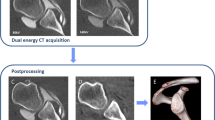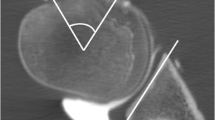Abstract
The role of conventional arthrography versus computed tomography (CT) arthrography of the glenohumeral joint using iotrolan was evaluated in patients with different shoulder problems. In addition, a diagnostic combination of conventional and CT arthrography was compared with magnetic resonance (MR) arthrography of the glenohumeral joint. Two diagnostic protocols were used. Protocol 1: conventional followed after 30 min by CT arthrography of 37 joints using a double contrast technique with iotrolan 300. Protocol 2: conventional followed after 90–180 min by MR arthrography in 20 patients using a single-contrast technique with 10 ml iotrolan 300 and 1 ml gedopentetate dimeglumine 500 mM. Ten patients also underwent CT arthrography. Neither patient group experienced contrast-related complications. Image quality was good for all conventional arthrograms, excellent in 45/47 CT arthrograms and good in 20 MR arthrograms. CT and MR arthrography were diagnostically valuable in many patients. We conclude that glenohumeral joint evaluation should be perfomed first using conventional or CT arthrography. Iotrolan has proven to be highly reliable and safe in these applications. Iotrolan in combination with gadopentetate dimeglumine, permits MR arthrography following completion of the standard examinations if necessary.
Similar content being viewed by others
References
Moseley HF, Oevergaard B (1962) The anterior capsular mechanism in recurrent anterior dislocation of the shoulder. J Bone Joint Surg [Am] 44B:913–927
Mink JH, Harris E, Rappaport M (1985) Rotator cuff tears: evaluation using double contrast shoulder arthrography. Radiology 157:621–623
Goldman AB, Ghelman B (1978) The double-contrast shoulder arthrogram. Radiology 127: 655–663
Stiles RG, Otte MT (1993) Imaging of the shoulder. Radiology 188: 603–613
Mack LA, Matsen FA, Kilcoyne RF, Davies PK, Sickler ME (1985) US evaluation of the rotator cuff. Radiology 157: 205–209
Middleton WD (1989) Status of rotator cuff sonography. Radiology 173: 307–309
Middleton WD (1993) Sonographic detection and quantification of rotator cuff tears. AJR 160: 109–110
Wiener SN, Seitz WH (1993) Sonography of the shoulder in patients with tears of the rotator cuff: Accuracy and value for selecting surgical options. AJR 160: 103–107
Schmidt M, Taenzer V, Wenzel-Hora BI (1987) Methodology and imaging contrast in arthrography of the shoulder. Roentgenpraxis 40: 413–421
Pennes DR (1990) Shoulder joint: Arthrographic CT appearance. Radiology 175: 878–879
Rafii M, Firooznia H, Golimbu C, Minkoff J, Bonamo J (1986) CT arthrography of capsular structures of the shoulder. AJR 146: 361–367
Hunter JC, Blatz DJ, Escobedo EM (1992) SLAP lesions of the glenoid labrum: CT arthrographic and arthroscopic correlation. Radiology 184: 513–518
Singson RD, Feldman F, Bigliani LU (1987) Recurrent shoulder dislocation after surgical repair: Double-contrast CT arthrography. Radiology 164: 425–428
Singson RD, Feldman F, Bigliani LU (1987) CT arthrographic patterns in recurrent glenohumeral instability. AJR 149: 749–753
Wilson AJ, Totty WG, Murphy WA, Hardy DC (1989) Shoulder joint: arthrographic CT and long term follow up, with surgical correlation. Radiology 173: 329–333
Garneau RA, Renfrew DL, Moore TE, El-Khoury GY, Nepola JV, Lemke JH (1991) Glenoid labrum: evaluation with MR imaging. Radiology 179: 519–522
Huber DJ, Sauter R, Mueller E (1986) MR imaging of the normal shoulder. Radiology 158: 405–408
Zlatkin MB (1991) MRI of the shoulder. Raven, New York
Palmer WE, Brown JH, Rosenthal DI (1993) Rotator cuff: evaluation with fat-suppressed MR arthrography. Radiology 188: 683–687
Hajek PC, Sartoris DJ, Neumann CH, Resnick D (1987) Potential contrast agents for MR arthrography: in-vitro evaluation and practical observations. AJR 149: 97–104
Hajek PC, Sartoris DJ, Gylys-Morin V, Haghighi P, Engel A, Kramer F, et al. (1990) The effect of intra-articular gadolinium-DTPA on synovial membrane and cartilage. Invest Radiol 25: 179–183
Flannigan B, Kursunoglu-Brahme S, Snyder SJ, Karzel R, Del Pizzo W, Resnick D (1990) MR arthrography of the shoulder: comparison with conventional MR imaging. AJR 155: 829–832
Kopka L, Funke M, Fischer U, Keating D, Oestmann J, Grabbe E (1994) MR arthrography of the shoulder with gadopentetate dimeglumine: Influence of concentration, iodinated contrast material, and time on signal intensity. AJR 163: 621–623
Gachter A, Seelig W (1992) Arthroscopy of the shoulder. Arthroscopy 8: 89–97
Buss DD, Warren RF, Galinat BJ (1991) Indications for shoulder arthroscopy. In: McGinty JB (ed) Operative arthroscopy. Raven, New York
Schmidt M, Papassotiriou (1989) Arthrography with Iotrolan: double-blind comparison between nonoinic, monomeric (Iohexol 300) and nonionic, dimeric (Iotrolan 300) contrast media. In: Taenzer V, Wende S (eds) Recent developments in nonionic contrast media. Thieme, Stuttgart, pp 182–189
Corbetti F, Malatesta V, Camposampiero A, Mazzi A, Punzi L, Angelini F, et al. (1986) Knee arthrography: effect of various contrast media and epinephrine on synovial fluid. Radiology 161: 195–198
Hall FM, Goldberg RP, Wishak G, Kilcoyne RF (1985) Arthrography-comparison of morbidity after use of various contrast media. Radiology 154: 339–341
Obermann WR, Bloem JL, Hermans J (1989) Knee arthrography: comparison of iotrolan and ioxaglate sodium meglumine. Radiology 173: 197–201
van Bree H, van Rijssen B, Tshamala M, Maenhout T (1992) Comparison of the non ionic contrast agents, iopromide and iotrolan, for positive-contrast arthrography of the scapulohumeral joints in dogs. Am J Vet Res 52: 1622–1626
Jinkins JR, Robinson JW, Sisk L, Fullerton GD, Williams RF (1992) Proton relaxation enhancement associated with iodinated contrast agents in MR imaging of the CNS. AJNR 13: 19–27
Kopka L, Funke M, Fischer U, Grabbe E (1993) Signal intensity of various iodinated contrast agents and their effects on the gadopentetate dimeglumine-dependent relaxation times in MR imaging (abstract). Radiology 189(P):246
Author information
Authors and Affiliations
Rights and permissions
About this article
Cite this article
Kopka, L., Funke, M., Vosshenrich, R. et al. Arthrography of the glenohumeral joint: experience with a non-ionic dimeric contrast agent and future perspectives. Eur. Radiol. 5 (Suppl 2), S18–S23 (1995). https://doi.org/10.1007/BF02343256
Issue Date:
DOI: https://doi.org/10.1007/BF02343256




